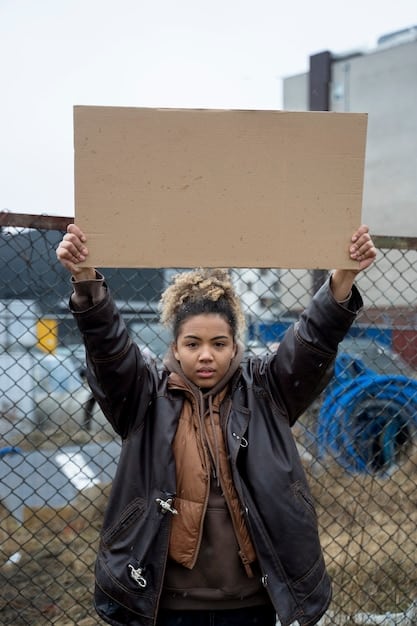The Future of Policing in America: Reforms, Racism & Brutality Data

The future of policing in America faces scrutiny over whether reforms adequately address systemic racism and reduce police brutality, spotlighting the need for comprehensive data and effective strategies.
The issue of The Future of Policing in America: Are Reforms Going Far Enough to Address Systemic Racism, and What are the Latest Data on Police Brutality? is a complex and urgent one, demanding a thorough examination of current practices and proposed changes.
Understanding Systemic Racism in Policing
Systemic racism in policing refers to the embedded biases and discriminatory practices within law enforcement agencies that disproportionately affect people of color. These issues have deep historical roots and continue to manifest in various forms today.
Historical Context
The history of policing in America is closely tied to the legacy of slavery and racial segregation. Early forms of law enforcement were often used to control and oppress enslaved populations and later to enforce discriminatory Jim Crow laws.
Manifestations of Systemic Racism
Systemic racism appears in arrest rates, sentencing disparities, and the use of force. Studies consistently show that people of color are more likely to be stopped, searched, and arrested for similar offenses compared to their white counterparts.

Here are some examples of the manifestations of systemic racism:
- Racial profiling during traffic stops and pedestrian encounters.
- Disproportionate use of force against people of color.
- Higher rates of incarceration for minority groups.
- Unequal application of justice within the legal system.
Addressing systemic racism requires a multifaceted approach, including policy changes, training reforms, and increased accountability. It also involves acknowledging and rectifying the historical injustices that have shaped the current state of policing.
Current Police Reform Efforts
In response to widespread protests and calls for change, various police reform efforts have been implemented across the United States. These reforms aim to address issues such as excessive force, racial bias, and lack of accountability.
Body Cameras and Transparency
One of the most common reforms is the implementation of body cameras. The goal is to increase transparency and accountability by recording interactions between officers and the public.
De-escalation Training
De-escalation training teaches officers how to use communication and tactical strategies to defuse potentially volatile situations. This training aims to reduce the use of force and promote safer outcomes for both officers and civilians.

Here are some examples of current reform efforts that are being implemented:
- Implementing community policing strategies to build trust between officers and the communities they serve.
- Reviewing and revising use of force policies to emphasize de-escalation and proportionality.
- Promoting diversity and inclusion within police departments to better reflect the communities they serve.
- Establishing civilian review boards to provide independent oversight of police conduct.
While these reforms represent progress, their effectiveness in addressing systemic racism is a subject of ongoing debate. Some argue that they do not go far enough to fundamentally change the culture and practices of policing.
Analyzing Data on Police Brutality
Data on police brutality is crucial for understanding the scope and nature of the problem. However, collecting accurate and comprehensive data remains a significant challenge.
Challenges in Data Collection
One of the primary challenges is the lack of a standardized national database for reporting police misconduct. Many incidents go unreported or are not accurately recorded, making it difficult to assess the true extent of police brutality.
Key Findings from Available Data
Despite these challenges, available data reveals troubling trends. Studies consistently show that people of color are disproportionately affected by police use of force.
Key findings from available data include:
- Black individuals are three times more likely to be killed by police than white individuals.
- Hispanic individuals are also disproportionately affected by police use of force.
- A significant percentage of police killings involve individuals who are unarmed.
- There is a lack of accountability for officers involved in fatal shootings.
These data points underscore the urgent need for more comprehensive and transparent data collection efforts. They also highlight the importance of addressing the underlying systemic issues that contribute to police brutality.
The Role of Community Policing
Community policing is a strategy that emphasizes building relationships and trust between police officers and the communities they serve. It involves officers working closely with residents to identify and address local problems.
Benefits of Community Policing
Community policing can lead to improved communication, increased cooperation, and a greater sense of safety within communities. It can also help to reduce crime rates and improve overall quality of life.
Challenges in Implementing Community Policing
Implementing community policing effectively requires a significant investment of time and resources. It also requires a shift in mindset from traditional law enforcement approaches.
Some of the challenges include:
- Building trust between officers and residents, especially in communities with a history of strained relationships.
- Providing officers with the training and support they need to effectively engage with communities.
- Ensuring that community policing efforts are sustainable and do not fade away over time.
- Measuring the impact of community policing on reducing crime and improving community relations.
Despite these challenges, community policing holds great promise for transforming the relationship between police and the communities they serve. It represents a move towards a more collaborative and problem-solving approach to law enforcement.
Alternatives to Traditional Policing
In recent years, there has been growing interest in exploring alternatives to traditional policing models. These alternatives aim to address the root causes of crime and reduce reliance on law enforcement.
Mental Health Crisis Response Teams
One promising alternative is the use of mental health crisis response teams. These teams consist of mental health professionals who respond to calls involving individuals experiencing mental health crises. The goal is to provide appropriate care and support, rather than resorting to arrest or use of force.
Community-Based Violence Interruption Programs
Another alternative is community-based violence interruption programs. These programs employ individuals who have credibility within the community to mediate conflicts and prevent violence. They work to build relationships, provide support, and connect individuals with resources.
Some other alternatives to traditional policing include:
- Investing in community-based organizations that address the root causes of crime.
- Providing affordable housing, job training, and educational opportunities to reduce poverty and inequality.
- Implementing restorative justice programs that focus on repairing harm and promoting accountability.
- Decriminalizing certain offenses, such as drug possession, to reduce the burden on the criminal justice system.
By exploring these alternatives, communities can move towards a more holistic and preventative approach to public safety.
The Path Forward: Comprehensive Solutions
Addressing the issues of systemic racism and police brutality requires a comprehensive approach that goes beyond piecemeal reforms. It requires a fundamental rethinking of the role of policing in society.
Legislative and Policy Changes
Legislative and policy changes are essential for creating a more just and equitable system. This includes implementing stricter use of force policies, increasing accountability for police misconduct, and ending racial profiling.
Community Involvement and Oversight
Community involvement and oversight are also crucial. Civilian review boards should have the power to investigate complaints, subpoena witnesses, and recommend disciplinary action.
Comprehensive steps to creating solutions can include:
- Investing in data collection and analysis to better understand the scope and nature of police misconduct.
- Providing ongoing training to officers on implicit bias, cultural sensitivity, and de-escalation techniques.
- Promoting diversity and inclusion within police departments to better reflect the communities they serve.
- Building trust between officers and residents by implementing community policing strategies.
By working together, communities, policymakers, and law enforcement agencies can create a future where everyone is treated with fairness, dignity, and respect.
| Key Point | Brief Description |
|---|---|
| ⚖️ Systemic Racism | Embedded bias affecting people of color in law enforcement. |
| 📹 Body Cameras | Increase transparency by recording police interactions. |
| 🤝 Community Policing | Building relationships between police and communities. |
| 🌱 Alternative Approaches | Mental health crisis teams and violence interruption programs. |
Frequently Asked Questions
▼
Systemic racism in policing refers to the embedded biases and discriminatory practices within law enforcement that disproportionately affect people of color. It manifests in various forms, including racial profiling and unequal application of justice.
▼
Body cameras can increase transparency and accountability by recording interactions between officers and the public. However, their effectiveness depends on policies that ensure proper use, storage, and public access to footage.
▼
Community policing can improve communication, increase cooperation, and foster a greater sense of safety within communities. It involves officers working closely with residents to identify and address local problems collaboratively.
▼
Alternatives include mental health crisis response teams and community-based violence interruption programs. These aim to address the root causes of crime and reduce reliance on law enforcement for issues like mental health crises.
▼
Communities can get involved by participating in civilian review boards, advocating for policy changes, and engaging in community policing initiatives. They can also support community-based organizations that address the root causes of crime.
Conclusion
The future of policing in America hinges on addressing systemic racism and police brutality through comprehensive reforms, data transparency, and community involvement, fostering a fairer and more equitable system for all.





